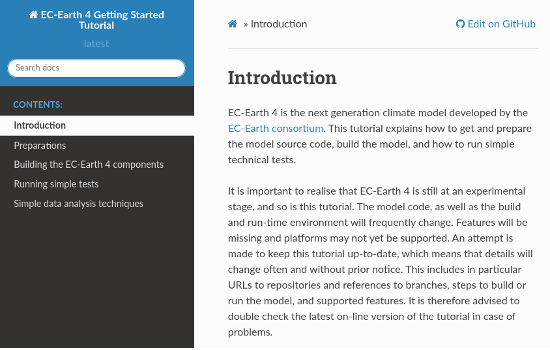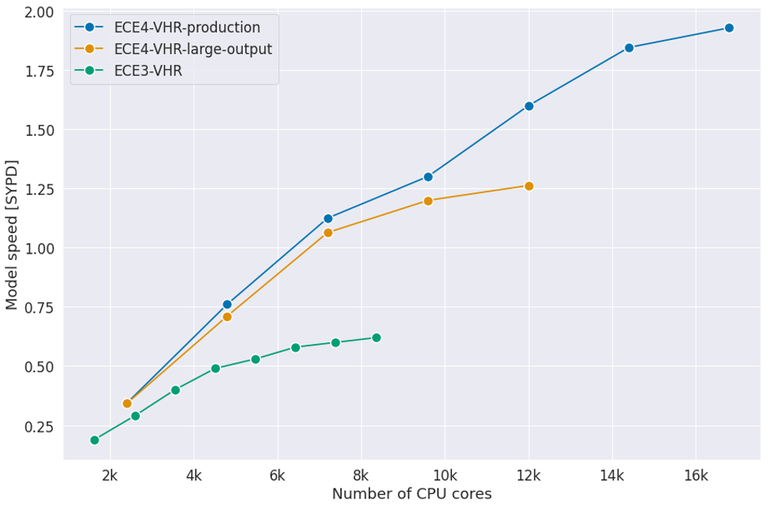EC-Earth is one of the Earth System Models being further developed with the support of the ESiWACE2 CoE and its services. As part of this development, BSC and SMHI have substantially contributed to the development of EC-Earth4, the next generation of the model that has taken shape and become available to early adopters in the community. This new model version constitutes a major step for the scientific and technical capabilities of EC-Earth.
Fostering collaboration, improving computational efficiency, introducing new capabilities
One of the major activities supported by ESiWACE and ESiWACE2 was the transition to OpenIFS as the atmosphere component of the Earth System Model (ESM), which provides a number of advantages: Due to the permissive license, it opens up the EC-Earth consortium to a wider community. The smaller gap between the OpenIFS roadmap and the ECMWF development of IFS enables closer collaboration between the scientists and allows for tighter development processes. And not the least, the latest OpenIFS version will allow EC-Earth to make use of the computationally efficient triangular-cubic octahedral (Tco) type of grids.
Another milestone is the adoption of NEMO4, a renewed ocean model including the new SI3 sea-ice component, which brings new capabilities and scientific features. Furthermore, the upgrade to NEMO4/SI3 overcomes serious communication bottlenecks of previous versions.
Enhanced coupling and more flexible, more performant data output
Coupling between the physical domain components (such as atmosphere, ocean, sea-ice, etc) is an important aspect for ESMs, both scientifically and technically. In order to provide for the variety of model components and configurations that EC-Earth4 will support, including the very high resolution configurations developed in ESiWACE, the EC-Earth coupling workflow has been improved to allow for different grid configurations to be linked in a flexible way. This means that EC-Earth users can more easily switch between grid resolutions and explore different configurations.
Writing model output data to disk is another crucial aspect of running numerical ESM experiments. This has historically been a bottleneck in terms of computational performance, particularly when high resolution configurations are considered. ESiWACE2 has helped EC-Earth developers to address this bottleneck, both by funding the integration of the XIOS asynchronous output system into OpenIFS and providing services around the XIOS software. With the help of these activities, configuring EC-Earth4 output has become much easier and more flexible. Furthermore, and most importantly, the writing of output data to disk storage has become more performant.
Involving and training the user community
The development of a new model version entails a lot of technical work, but it is, in the end, the model users that will run numerical experiments and answer scientific questions. Hence, the involvement of the user community is crucial for model development. In order to involve early adopters for EC-Earth4, an online tutorial has been produced and a training session for the community has been provided, explaining practical steps for getting started with EC-Earth4.
Tackling very high-resolution simulations and computational performance
At the heart of ESiWACE2 activities lie, of course, very high-resolution simulations and computational performance. Consequently, a very-high resolution atmosphere-ocean coupled (VHR-GCM) configuration of EC-Earth4 has been developed, tested, and optimised. An analysis of the scalability (including the aforementioned output system) has been conducted and the model configuration is being ported to EuroHPC machines in preparation for exascale systems. The corresponding activities in work package WP1 of ESiWACE2 provide an important test bed for EC-Earth4, particularly in its high and very high resolution GCM configurations.
The VHR-GCM configuration has previously been defined in ESiWACE (the ESiWACE2 predecessor) with the aim of validating the models’ capability and efficiency to perform integrations with extreme computational demands. In ESiWACE2, this demonstrator has been further developed into a “production version”, with the ambitious goal to run the model at a sustained speed of 1 simulated years per day (SYPD) while at the same time producing sufficient model data output to ensure production capability. Moreover, EC-Earth4 has been benchmarked with a high-end output configuration, to validate the maximum model capacity in providing detailed results. The scalability plot above illustrates the improvement and impact on the performance of the model for both output configurations.
EC-Earth4 development continues
The development of EC-Earth4 will be continued during the ESiWACE2 project and beyond, but groundwork has been laid for an ESM that can cover the needs of a future CMIP cycle. Detailed information about the model configuration and performance of EC-Earth4 is found in the ESiWACE deliverable D1.1 “Simulations of global high-resolution climate and weather models in production mode” (December 2021).
Uwe Fladrich (SMHI), Kim Serradell and Miguel Castrillo (BSC)


